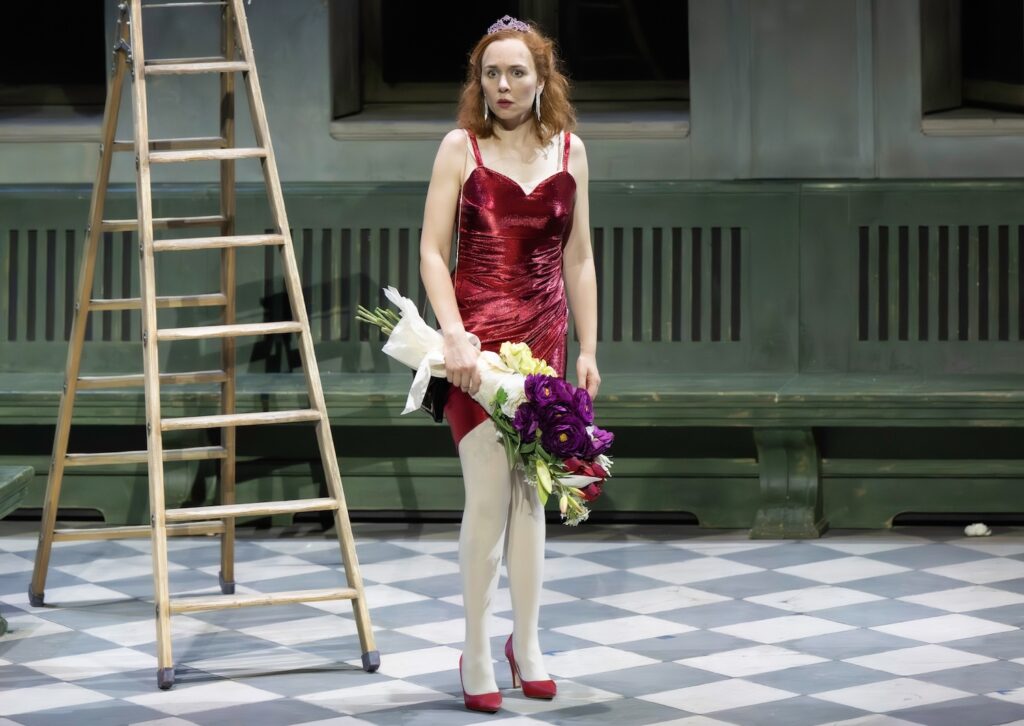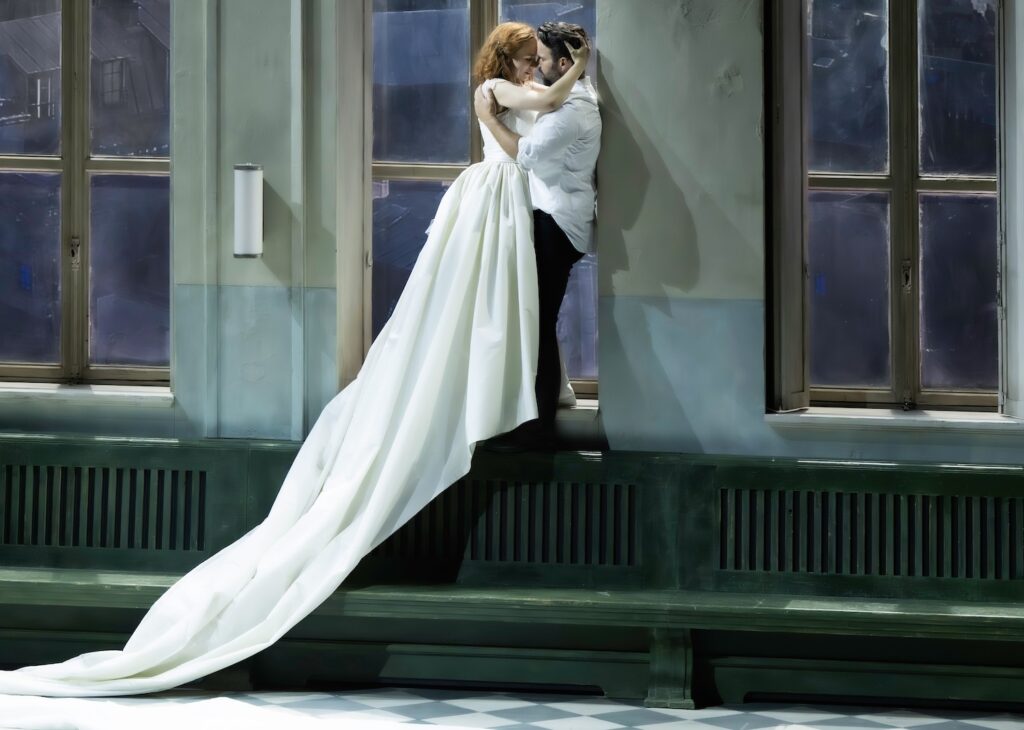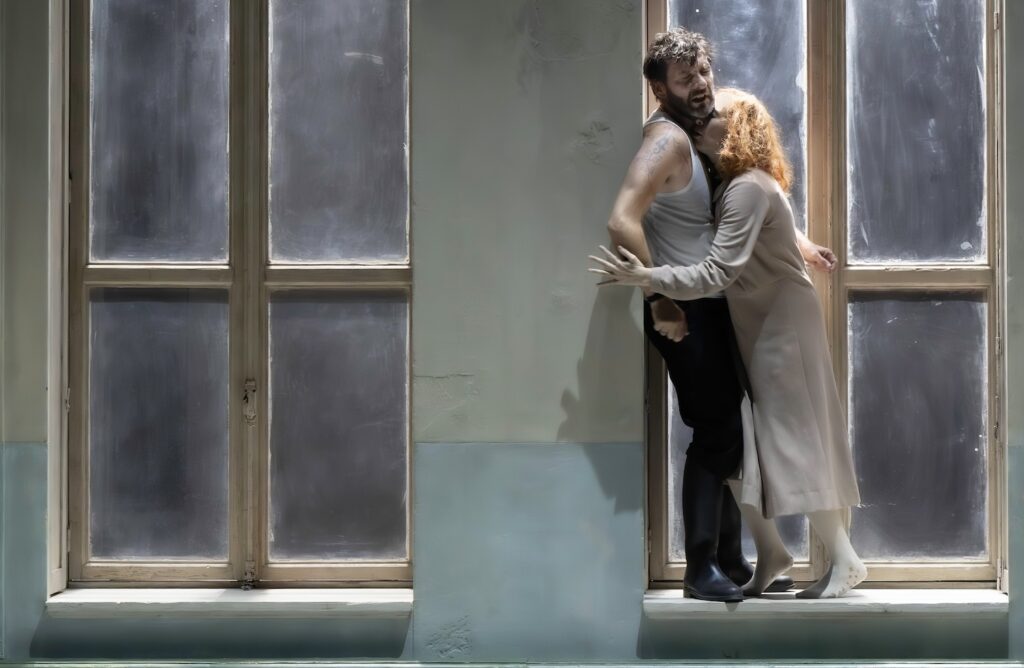Most of us know “Depuis le jour” from Louise, but few of us know Gustave Carpentier’s opera Louise. The Aix Festival has just now reintroduced the opera in a production that will continue on to Lyon and Paris, surely bringing the opera to greater fame.
It is inevitable that the opera Louise (1894) remain a dark horse in the repertory. Its story, like Puccini’s La boheme (1898), is set in Paris’ Montmartre, its players are artists and seamstresses, not exactly Zola’s coal miners or Flaubert’s petite bourgeoisie, but cut from the same “naturalism” cloth — Louise is an overprotected child who breaks out into the Bohemian world, only to return, at her mother’s entreaties, to her ailing father.
Charpentier’s opera however reveals a much larger and richer artistic world. Musically it unfolds in the traditionally rich, French orchestral colors, though in a Wagnerian flow, harmonically it anticipates Schönbergian post-Romanticism (Verklärte Nacht comes in 1899), and melodically it paves the way to the disjointed lines of serial composition. Its prose libretto, created by the composer, flirts notably with the spirituality of symbolism in “Depuis le jour” and in its ode to the freedoms of Parisian bohemian life, while telling its sad, gritty, working class story.
German stage director Chistof Loy takes Charpentier’s Louise to its symbolist, surreal conclusion, playing with its realism roots. Working in the old guard vocabulary of the German theatrical avant-garde the opera’s four acts unfold in one monumental waiting room with five huge windows that frequently open and close, letting the world out and in. But you don’t know what its occupants are waiting for — it seems a public space (like a train station), but there are vestiges of medical offices. There are often extraneous people sitting in the space. We understand that they too have stories to tell, and that the story we are being told is just one of many.
The Christof Loy production opens in silence [actually to the popping of ex-theatre, pre-Bastille Day firecrackers]. The silence extends, a woman walks across the stage and exits, the others leave as well. The woman’s daughter, whom we understand to be Louise, is now alone on the stage (lead photo, left to right Sophie Koch as the mother, Elsa Dreisig as Louise, Nicolas Courjal as the father).
Charpentier’s opera begins.
The daughter, Louise, writes a letter, seals and addresses it — we will perceive sometime within the next three hours that the entire opera occurs within the imagination of Louise while she waits for an appointment with her doctor. It is a love letter that she hands to her father. Only after the evening is over will all this come together as we reconsider what we have seen. The episodes that so confused us will fall into place and we have the realization that we are a part of this symbolist drama, as we too had to re-imagine the opera Louise.
Louise is obsessed with her love for her father, she imagines him as her lover, though the imagined lover is also her doctor (whom we only fleetingly see, at the end). Both men are embodied in her imagined fiancé, Julien. She imagines a marriage wearing a wedding dress with a hugely long train that she and everyone on stage must tiptoe around or gather up from time to time to get out of the way..
In this disturbed state she attempts to express happiness in her famed aria. She is then crowned Queen of Montmartre in a huge scene celebrating Paris, only to find herself in a very skimpy, red sequined dress to accept a presentation of roses. She drops the roses (which are kicked around the waiting room for most of the rest of the opera), and returns home to rape her father in a final act of liberation.

To be sure it was a big job for dramaturg Louis Geisler; no stranger to difficult concept stagings having overseen the recent, bizarre Manon at the Paris Opera and the amazing, lecture hall Cosi fan tutte last month at the Lyon Opera.
It was all held together by Pesaro trained conducting star Giacomo Sagripanti who urged the Orchestre de l’Opéra de Lyon to a full throated reading of the Charpentier score, everyone obviously relishing its extreme chromaticism. The prose libretto demands a committed flow of musical ideas that continuously evolve, the maestro finding the needed tensions to keep us involved during our extended periods of dramaturgical confusion. Both the maestro and the stage director played ruthlessly with Charpentier’s intuition that we are all waiting to break out of our lives.
The Chistof Loy production demanded an extraordinary cast, which the Aix Festival provided. French/Danish soprano Elsa Dreisig, the Aix Festival’s 2022 Salome, enacted the troubled, terrified Louise, finding the vocal glories of “Depuis le jour” without forsaking her madness, finding the shame of appearing almost naked in public, and raping her father with repressed sexual energy. It was a complete performance.

British tenor Adam Smith played Julien, Louise’s imagined fiancé, with the light-footed grace required by a phantom presence. Mr. Smith sometimes inhabits the verismo repertory, though his voice resides more convincingly in the late nineteenth century French repertory. He navigated the role of the poet Julien with consummate ease.
French bass Nicolas Courjal played Louise’s father, by profession a scavenger of discarded furniture. Though Mr. Courjal’s career is centered on the international repertory’s major bass roles, in the first two acts of Louise he enacted an Offenbach comic bass, only to become a terrified father in huge outrage in the final scene of the opera. Mr. Courjal gave a complete performance.

Iconic French mezzo-soprano Sophie Koch played Louise’s mother. Mme. Koch is an electric presence who brought authority and stature to the role, evoking by her mere presence the dark and warm complexities of maternal relationship. Vocally the role does not sit comfortably in Mme. Koch’s range, histrionically it was perfection.
The opera holds two cameo roles of importance: the second act’s balayeuse (female janitor), though in the Christof Loy production she is a sophisticated bourgoise; and the pope of fools, the master of ceremony for the third act’s celebration of freedom. Both roles were ably executed by French soprano Annick Massis and French tenor Grégoire Mour respectively.
Composer Charpentier’s Wagnerism came to the fore in Act II, the mythical Valkyries becoming working class, Parisian seamstresses. It was a scene of great musical complexity that was expertly staged to reflect the political complexities of many women working in close quarters.
The set for the Christof Loy production was designed by Etienne Pluss, costumes were designed by Robby Duiveman, both men with extensive major German operatic credits. Lighting was by Italian designer Valerio Tiber.
Michael Milenski
Théâtre de l’Archevêché, Aix-en-Provence, France, July 9, 2025
All photos © Monika Rittershaus, courtesy of the Aix Festival